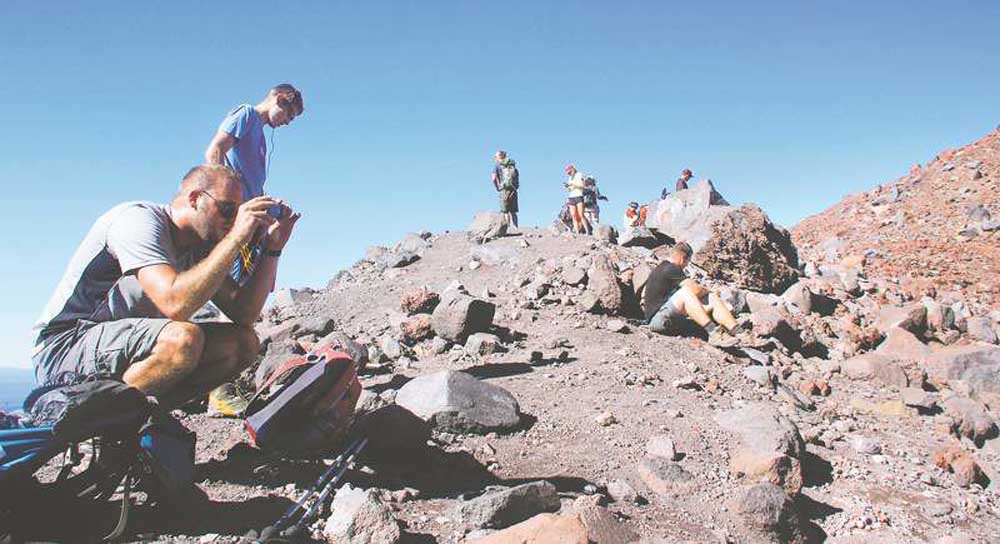Crowds in Three Sisters Wilderness pose a challenge for preservation
Published 5:00 am Wednesday, October 2, 2013

- Ryan Freeman, who traveled to Oregon from St. Paul, Minn., takes a picture last month at the ridge line at around 9,000 feet on South Sister. The mountain becomes very crowded during sunny days in August, September and sometimes into early October.
The answer was blunt.
When asked how one might avoid crowds when climbing South Sister or backpacking the Green Lakes Basin, Jonathan Erickson came straight to the point.
“You don’t avoid them, at least not really,” the lead wilderness ranger for Deschutes National Forest said. “The crowds taper off once the weather gets worse and you’ll find less people out there on a Wednesday. But to be frank, there really isn’t a way to avoid a busy setting.”
Crowds are nothing new in the Three Sisters Wilderness, a vast landscape of volcanoes, creeks and valleys extending 286,708 acres across both sides of the Cascade Range and offering some of Oregon’s most dramatic scenery.
But the large number of people crowding into one particular area — centered on South Sister, Broken Top, the Green Lakes Basin and Moraine Lake — has caused numerous headaches for rangers trying to balance wilderness preservation with recreation demands.
In the worst cases, people damage the fragile alpine environment by cutting down trees and leaving feces at campsites. But the overall impact is to create a place that, on sunny days during summer, feels more like the Mall of America than an Oregon wilderness.
“I don’t even consider it a wilderness experience,” said Chris Sabo, trail crew supervisor for Deschutes National Forest. “It’s almost more of an urban park. The use is very high, really beyond what this area can accommodate.”
The problematic area centers on two trailheads located just 30 minutes west of Bend on Cascade Lakes Scenic Byway.
And the allure is easy to understand.
The Green Lakes Trailhead, just across from Sparks Lake, begins a four-mile hike through waterfall-laden forest and ash canyons to a basin of emerald pools nestled between the towering peaks of South Sister and Broken Top. At one point, Deschutes Brewery honored the basin with a beer — Green Lakes Organic Ale.
Those seeking a bit more adventure can continue two miles down the highway to Devil’s Lake Trailhead, where a six-mile trail allows novice climbers the chance to reach South Sister’s 10,358-foot summit and peer out across half the state.
This combination of beauty, easy access and Oregon’s third-tallest summit create an area both spectacular and overrun.
There were 14,600 people who visited the South Sister, Green Lakes and Moraine Lake area in 2012 based on wilderness permits filled out — though the number has been closer to 18,000 in past years. A sunny weekend in August and September can see upwards of 400 people attempting to climb South Sister.
The crowds brought regulations and fines not typically seen in wilderness areas starting in the mid-1990s.
Backpackers are required to tent at designated campsites — there are 28 sites in the Green Lakes Basin and 22 at Moraine Lake. Campfires are strictly prohibited, and the fine for breaking that rule can reach a whopping $5,000 (though most first-time offenders would be hit with a “modest” $250 ticket).
“Campfires were a huge problem in the early 1990s,” Sabo said. “The area was so denuded of woody material — which is an essential component in fragile alpine basin — that people were actually cutting down tiny seedlings and saplings for fires.”
“It’s disheartening to go up there and see some of the behavior,” Erickson said. “Every week we’re finding people with illegal campfires, garbage left behind and unburied waste sitting right inside a camping spot.
“Yes, people are actually pooping at their own campsite and leaving it there.”
“Something people have to understand is that the environment is very fragile up there — the plants and trees are slow-growing and take well beyond a human lifetime to mature. Trying to limit the impact with this many people is the reason for the rules.”
The crowds climbing South Sister poise even greater issues. Although the trail from Devil’s Lake is nontechnical — it follows a trail almost all the way to the summit — the route still ascends a grueling 5,000 feet into thin air.
One option for limiting high use in the Three Sisters Wilderness has been a permit controlled, limited-entry system.
The Obsidian Trail Limited Entry Area, on the Willamette National Forest side of the Three Sisters, requires a permit to hike or backpack. Each day from May 1 to until the snow shuts down Highway 242 (Oct. 25 last year), there are 30 day-use and 40 overnight permits issued for entry.
The same system was considered for South Sister and Green and Moraine lakes in the Deschutes National Forest, but it ultimately wasn’t implemented.
“This is something we’ve been concerned about for quite some time and something we’ve been struggling with since the late 1980s,” Erickson said.
“If I could impart anything to the people visiting, it would be focusing on the principles of Leave No Trace, traveling in small groups and doing homework ahead of time on issues like taking care of their waste.”






